Slow Roasted Sirloin Of Beef (Reverse Seared)
Reverse searing is the secret to perfectly cooked roast beef! This slow roasted sirloin is pink from edge to edge & will melt in your mouth.
This post contains affiliate links.

We’re making the most tender, flavourful roast beef, that’s evenly cooked & pink from edge to edge!
In my opinion, this is the absolute best way to cook any cut of roast beef, especially sirloin! The trick here is to salt the beef overnight then roast it at a super low temperature (we’re talking 100°c/212°f!) until it’s cooked to a perfect medium rare. We then let it rest for an hour or so then sear well in an oven that’s set to its’ highest temperature. That’s all there is to it!
Cooking roast beef like this is ensures perfectly cooked meat that has a crisp, well seared crust. There’s no grey bands of overcooked meat around the outside of our roast beef!
Some exciting news! I’ve just released my roast dinner eBook over on my brand new online store! This contains everything you need to make a restaurant style roast dinner, including perfectly roasted meats, plenty of side dishes & sauces to serve with different meats.
What Is Reverse Searing?
Reverse searing has gained popularity over the last few of years & for good reason! This method of cooking involves slowly cooking meat at a low temperature, to your desired doneness then searing to finish (either in a super hot oven or in a pan).
Ever wondered how to cook steak & roast beef that’s pink from edge to edge? This is how!
What You’ll Need
The key to cooking really good roast beef, starts with the meat that you use! I’d recommend visiting your local butchers & asking for a rolled sirloin joint that has been dry aged for at least 28 days. For this recipe, we’re using a 1½ kg piece of beef which will easily serve 6 people.
You’ll also need a digital food probe, to check the internal temperature of the beef.
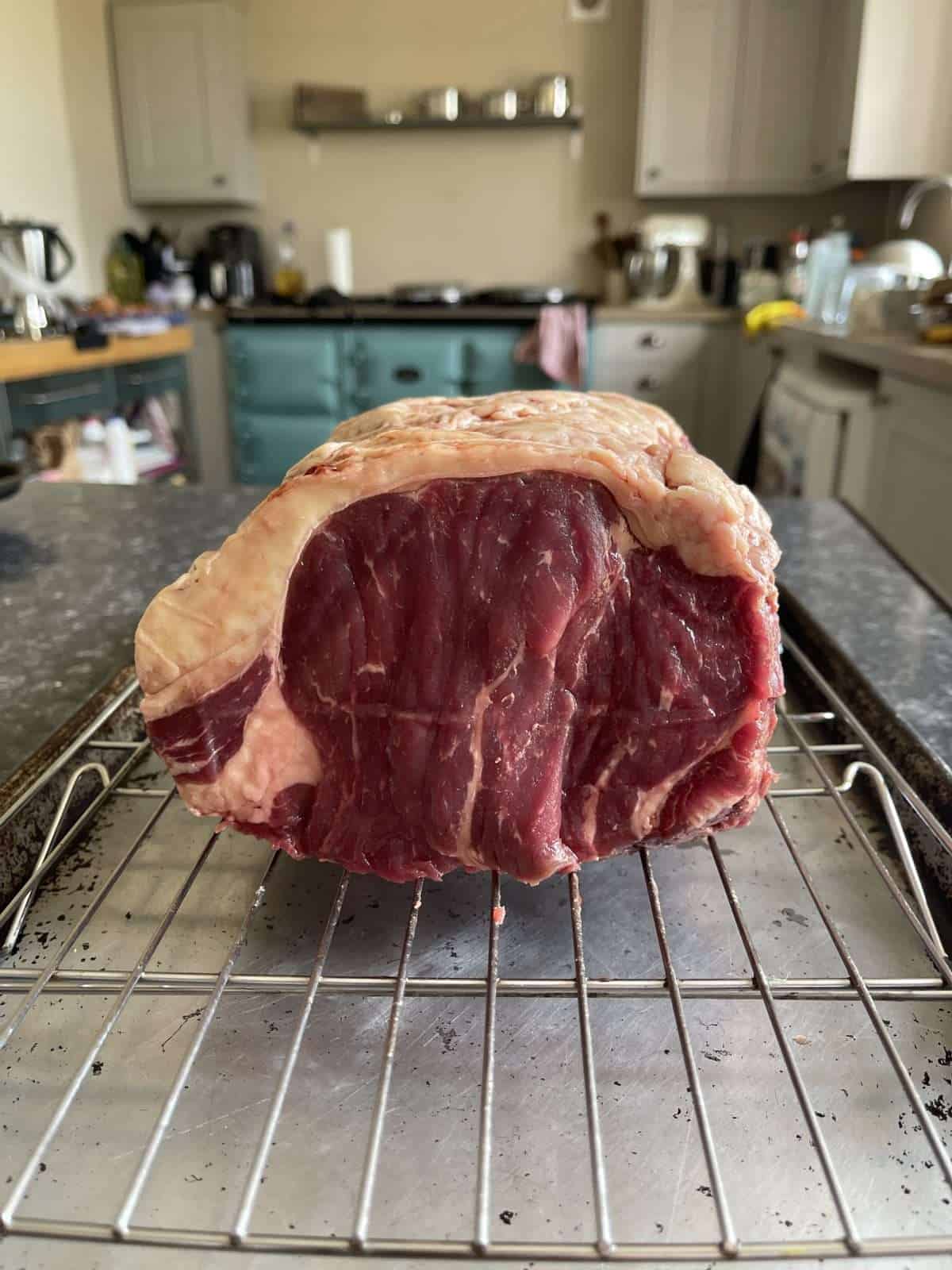
How To Make Reverse Seared Roast Beef
This style of roast beef can be broken down into 3 easy steps! The first step only takes a few minutes & is done the day before cooking.
We’re using a rolled sirloin for this recipe but this method will also work for most large cuts of beef…
Salting The Beef
The first step when making roast beef, is to season the outside of the beef with a light layer of fine sea salt (I use Maldon salt!) which we do this the day before cooking. This is known as a dry brine & is used to season the beef & to dry out the beef’s exterior, for an improved flavour, a more tender texture & a better sear.
The Science Behind Salting Beef
When you season the outside of your joint of beef with salt, the moisture from inside the meat is drawn to the outside. The salt then gets dissolved in this water, which creates a brine that is then reabsorbed by the meat. The longer you leave your beef after salting, the deeper the salt will penetrate, therefore seasoning more of the meat!
I find that salting the beef a whole day before cooking is best but if you’re short on time, 6 hours or so will do the trick. Although, I wouldn’t recommend salting the meat more than 2 days before cooking.
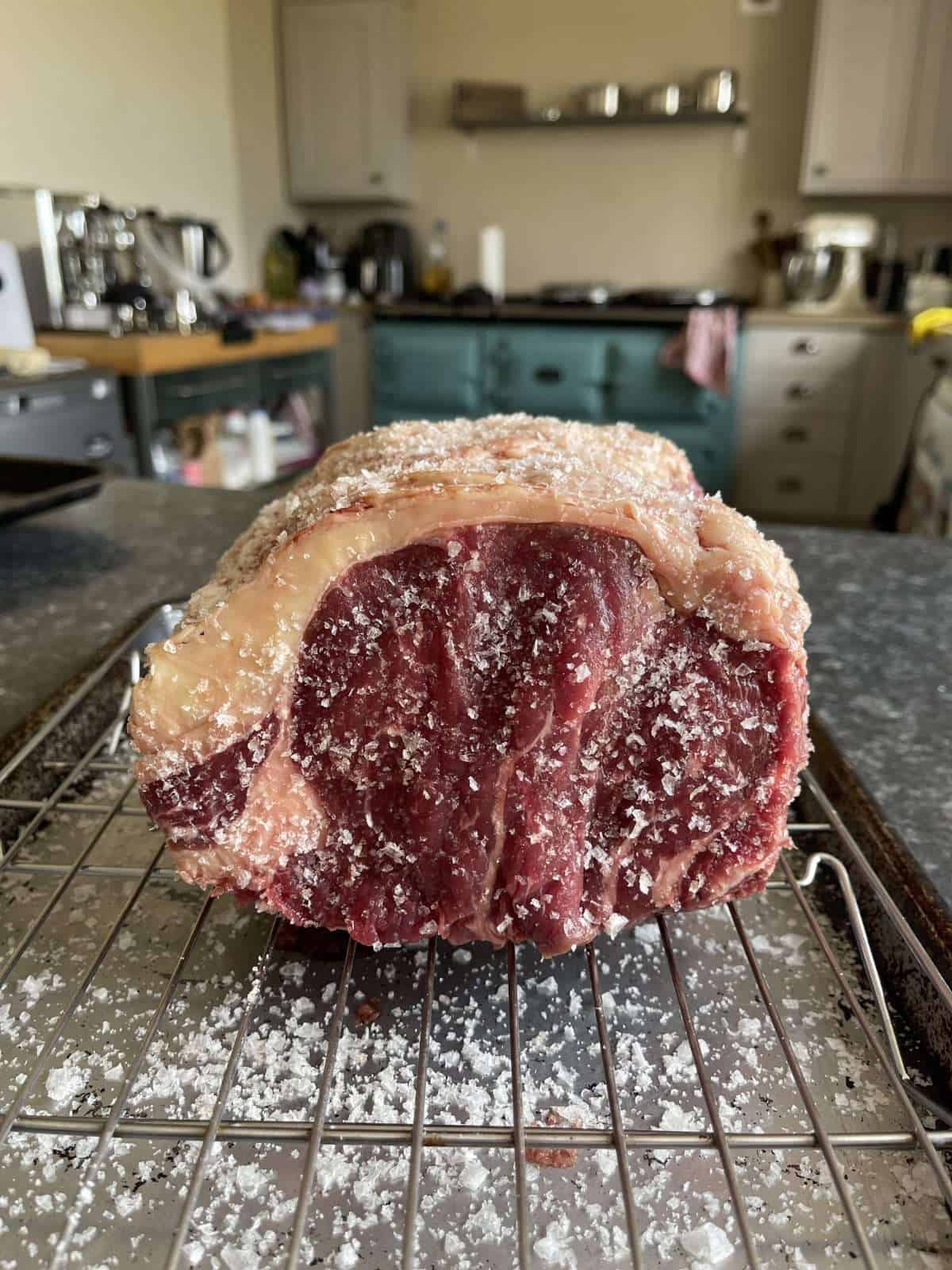
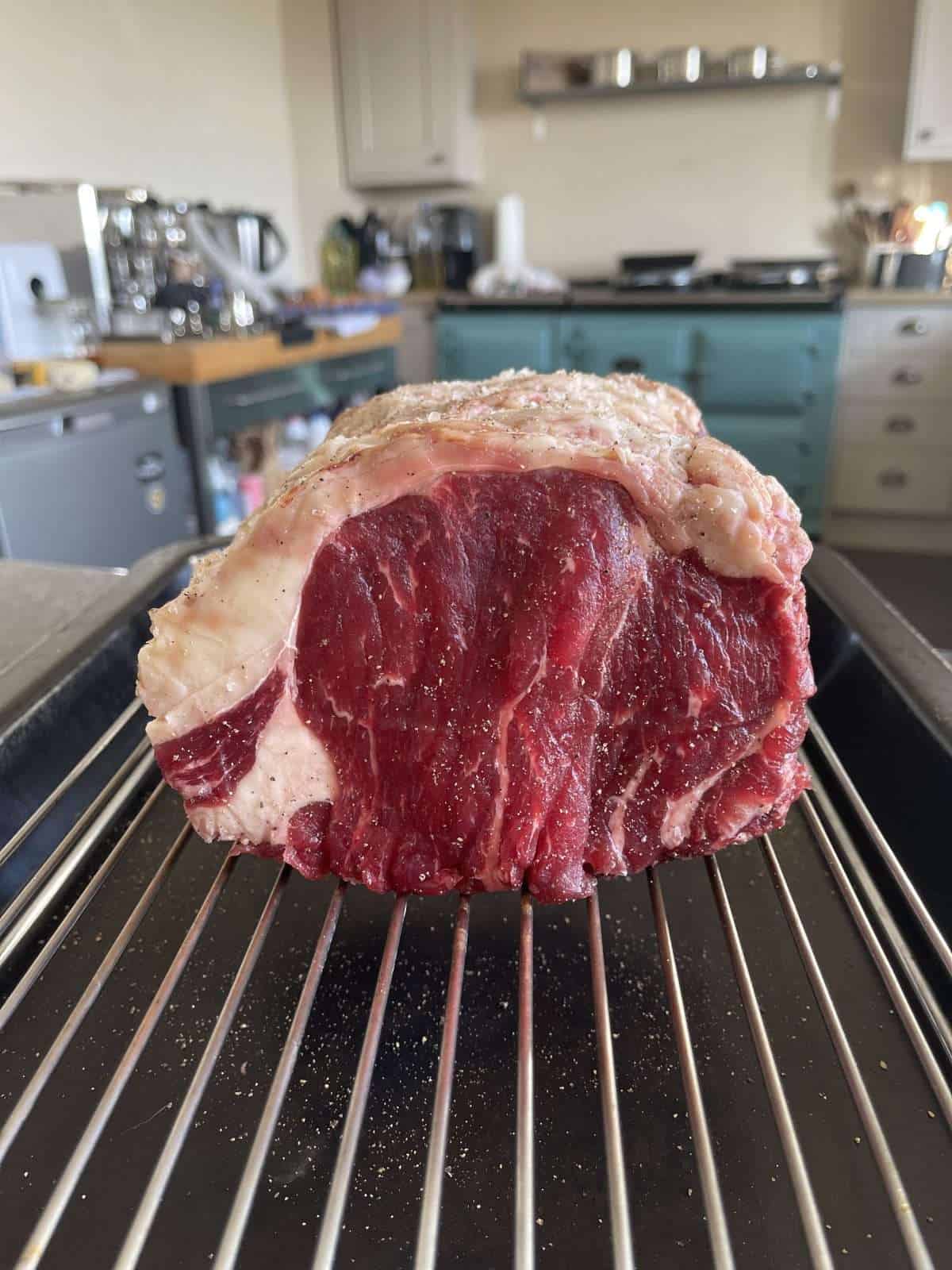
Slow Roasting
If you want your beef to be perfectly pink from edge to edge, slow roasting is the way to do it! By slowly cooking our joint of beef, at a lower oven temperature, we avoid that grey band of overcooked meat around the edge that you can get by roasting beef at a higher temperature. Here’s how to slow roast a joint of beef…
- Preheat your oven to 100°c/212°f. If your oven won’t got this low, set it to its’ lowest setting.
- Whilst your oven is heating up, take your beef out of the fridge & place onto a wire rack set inside a roasting tin.
- Season the outside of the beef with freshly cracked black pepper & leave to sit at room temperature for at least 30 minutes before cooking. We’ve already salted our beef, so there’s no need to season it again at this point!
- Cook your joint of beef in the preheated oven until the internal temperature in the middle of the beef reaches 52°c/125°f. This will roughly take between 2-2½ hours.
- Take the beef out of the oven, loosely cover the meat with foil then leave to rest for at least 30 minutes or up to 1½ hours.
Searing
Once you’ve slow roasted your beef, the meat will be cooked but still pale on the outside. This is why this method of cooking is called the reverse sear, because we sear the meat once it is cooked. Unlike regular roast beef, where you would sear the outside first.
Searing the beef couldn’t be easier! All we need to do here is turn our oven up as high as it will go then once our roasted beef has rested, we cook it for roughly 6-8 minutes, until the fat is crisp & the meat is well browned. We don’t want to overcook the beef at this point, so make sure that you don’t leave it in the oven for too long!
There’s no need to rest the beef again after it has been seared, simply remove any string then cut into slices!
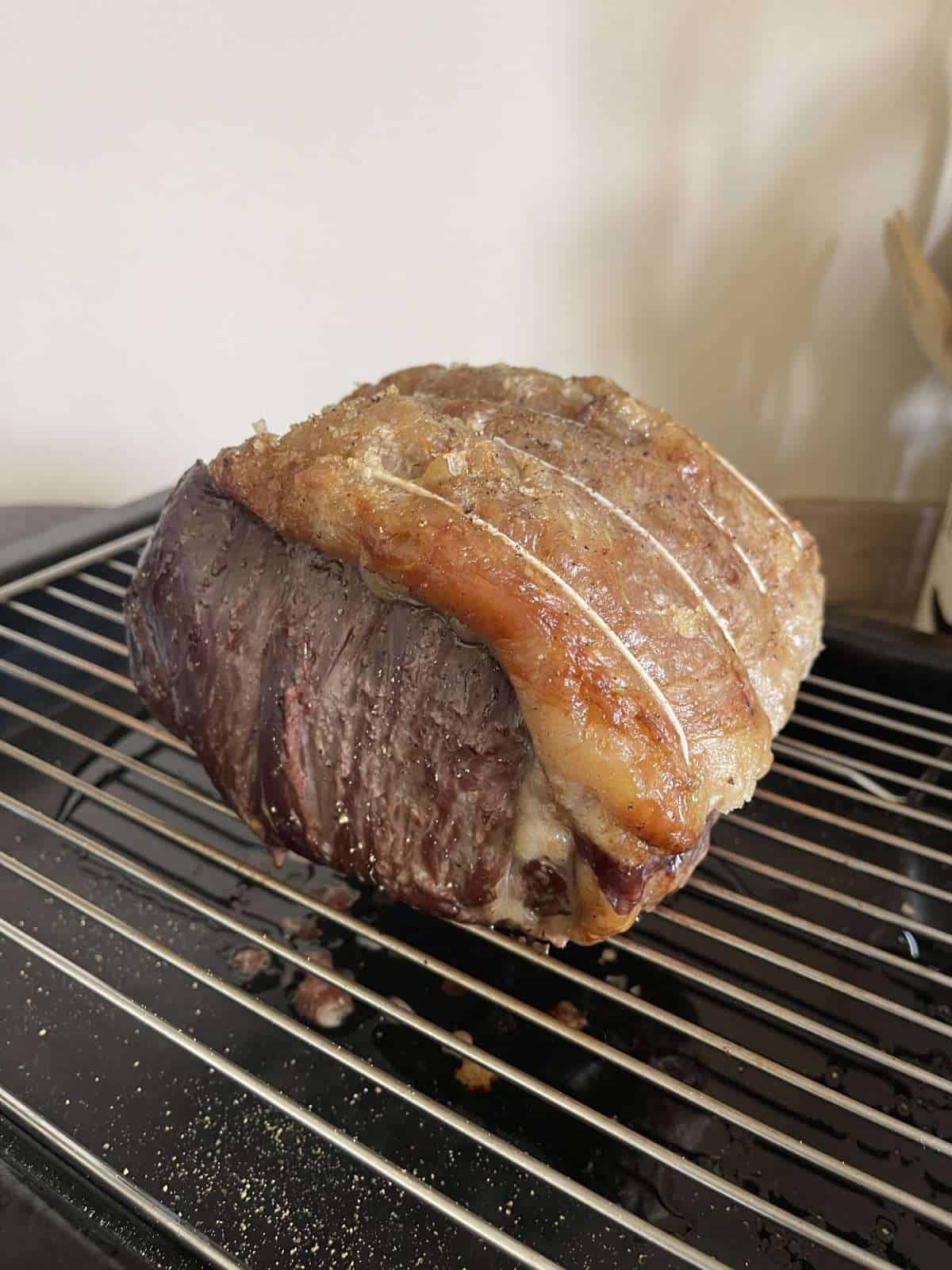
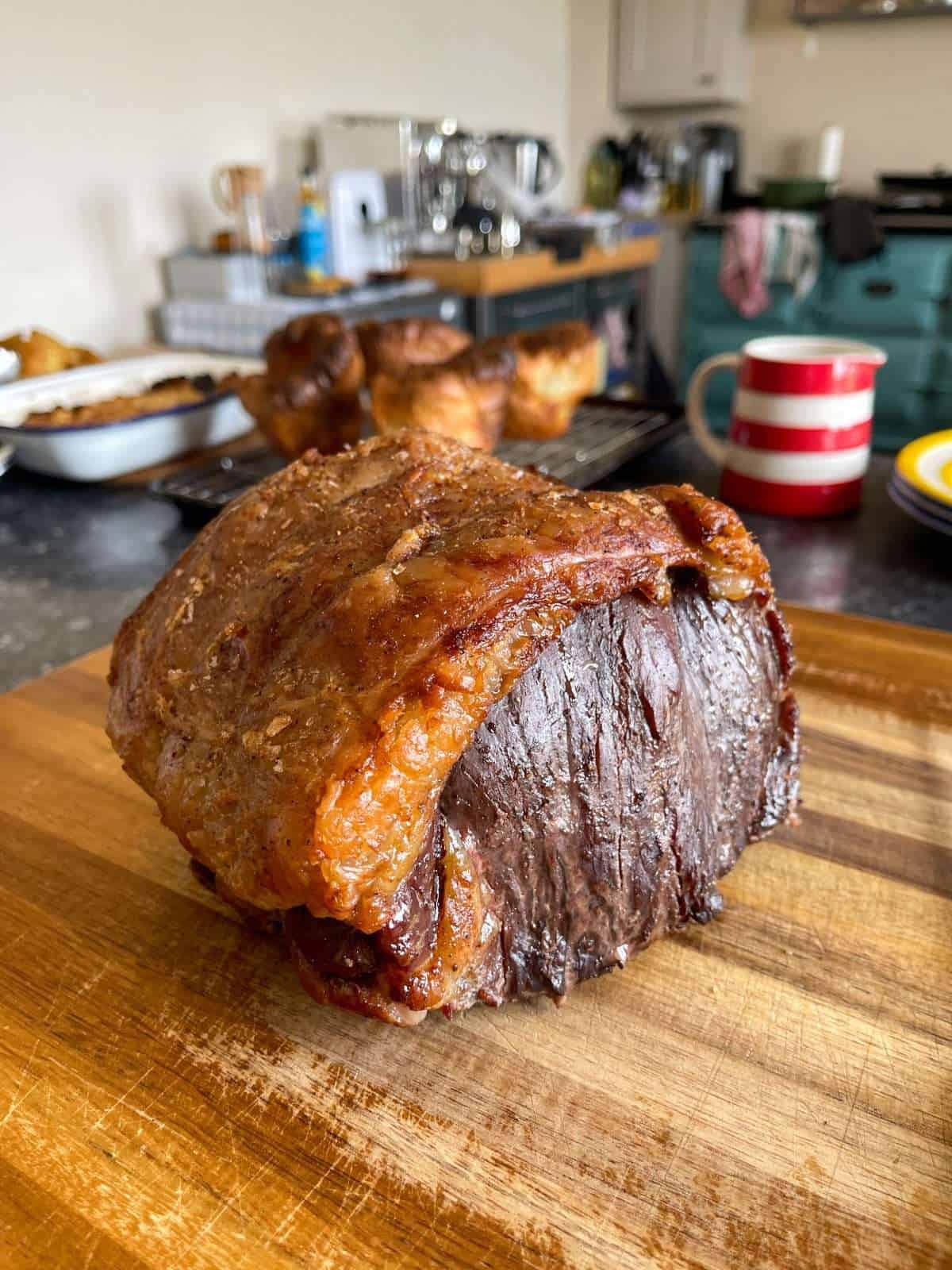
Tips & Tricks For Perfect Roast Beef
- Ask your butcher for a joint of beef that has been dry aged for at least 28 days.
- Salt your beef the day before cooking, for an improved flavour & better sear.
- Let your beef warm to room temperature before cooking, for a more even cook.
- For edge to edge pink meat, roast your beef at a lower temperature & sear just before serving (this is reverse searing!).
- Avoid overcooking your beef by using a digital food probe to check the internal temperature of the meat.
- Let your roast beef rest for at least 30 minutes, or up to 1½ hours after cooking (before searing).
Roast Beef Internal Temperature Guide
In my opinion, roasted sirloin of beef is best served medium rare, which is how I’d recommend cooking yours! Although I understand that everyone has a preference when it comes to how they like their beef cooked, so feel free to cook your beef how you like.
Here’s a guide to what internal temperature to cook your beef to, for each different cooking method (you’ll need a food probe!).
| Cooking Method | Internal Temperature (To Stop Cooking) | Internal Temperature (After Resting) |
| Rare | 46°c/115°f | 48°c/120°f |
| Medium Rare | 52°c/125°f | 54°c/130°f |
| Medium | 58°c/136°f | 60°c/140°f |
| Medium Well | 63°c/145°f | 65°c/150°f |
| Well Done | 68°c/154°f | 70°c/158°f |
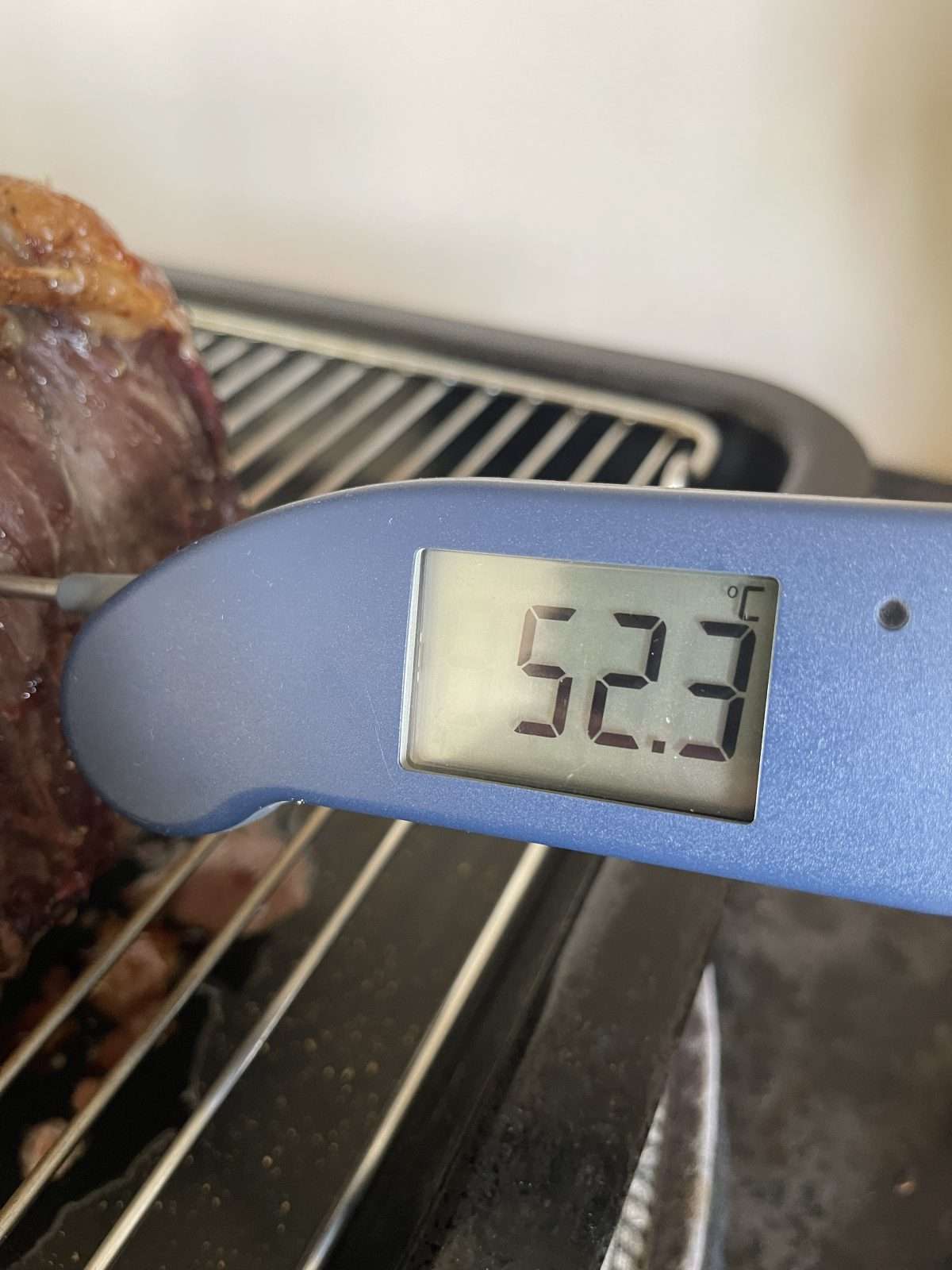
Frequently Asked Questions
The reverse searing method of cooking roast beef works great with any cut of beef that you’d normally use for roasting. Sirloin, prime rib, topside & rump are all good choices. The cooking method is the same whatever cut of beef you use. Keep in mind though, that if you use a bone in joint of beef, it will take slightly longer to cook.
Leftover roast beef should be stored in the fridge & will keep for up to 3 days. Where possible, I like to keep my leftover beef unsliced as slicing it as you need, will prevent the slices discolouring/oxidising. Leftover roast beef can be served either hot or cold! I like to make roast beef sliders with my leftovers!
Leftover roast is best reheated in gravy! To do this, cut your beef into slices & place into a heatproof dish with plenty of gravy. Cover the dish with foil then bake in a 180°c/356°f oven until hot. Keep in mind that the beef won’t be as pink once it has been reheated.
For the cleanest slices, it’s best to use a long (8″-12″), straight edged carving knife to slice your roast beef. Make sure it’s super sharp! You’ll also need a pair of scissors to remove any string/twine, that was used to tie the joint up.
Cooking Slow Roasted Beef In An Aga
With all of my recipes, I include cooking instructions for conventional ovens, fan ovens & also Agas. Here’s how to cook this recipe in an Aga…
Slow roast the beef in the simmering oven, on the bottom set of runners. Sear the beef in the roasting oven. Place your roasting tin as high in the roasting oven as you can, without it touching the top.
Equipment Used
Please note that these are affiliate links & I may make a small commission if you make a purchase using these links, at no extra cost to you. For more information, click here.
What To Serve With Slow Roasted Sirloin Of Beef
This roasted sirloin of beef is best served as part of a homemade roast dinner! Here’s the sides that I served with mine…
- Goose Fat Yorkshire Puddings
- Black Garlic Roast Potatoes
- 3 Cheese Cauliflower Cheese
- Honey Roasted Carrots & Parsnips
- Braised Red Cabbage
- Caramelised Onion & Sage Stuffing
- Red Wine Gravy
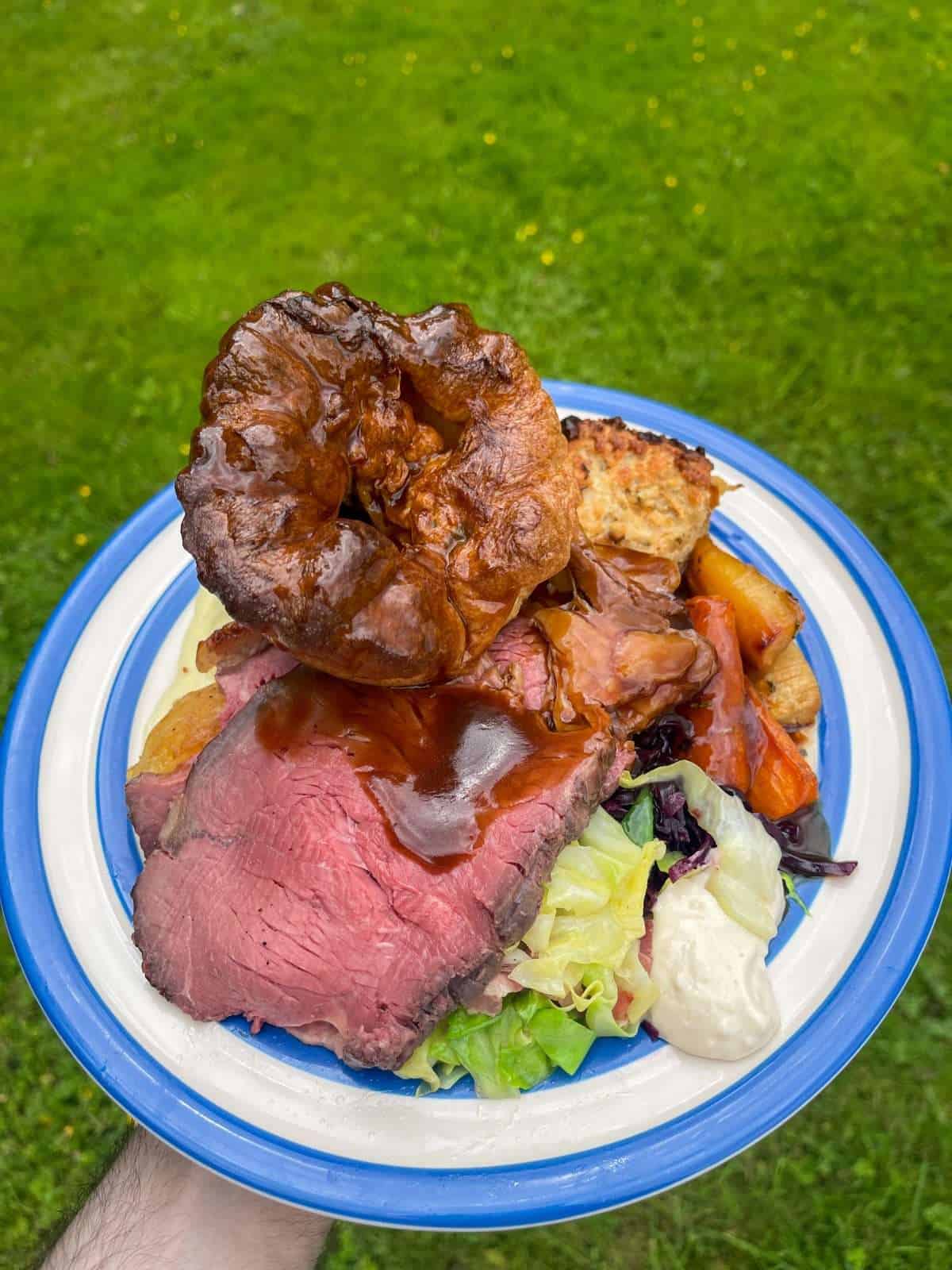
What’s For Dessert?
Want to finish your meal with a next level, homemade dessert? Here’s what we’d recommend…
If you have enjoyed this recipe for slow roasted sirloin of beef, it would mean a lot if you could leave a review & rating. And if you’d like to stay up to date with future recipes, follow us on Instagram & TikTok!
Slow Roasted Sirloin Of Beef (Reversed Seared)
Equipment
- Digital Food Probe
- Large Roasting Tin
- Wire Rack
Ingredients
- 1½ kg Rolled Beef Sirloin Joint (See Notes)
- Fine Sea Salt
- Freshly Cracked Black Pepper
Instructions
Beef Prep
- Lightly season the beef all over with sea salt then place onto a wire rack set over a baking tray (fat side up).
- Chill the beef in a fridge overnight, leaving it uncovered.Make sure to give the beef at least 12 hours in the fridge, or up to 2 days.
Cooking
- Preheat an oven to 100°c/80°c fan (212°f/176°f).If your oven doesn't go this low, set it as low as it will go!
- Whilst your oven is preheating, take your beef out of the fridge & place it onto a wire rack, set inside a roasting tin. Season the beef generously with freshly cracked black pepper & leave to sit at room temperature.
- Once your oven has preheated, add in your beef & cook until the internal temperature registers 52°c/125°f in the centre. This will take roughly 2-2½ hours.This is to cook the beef medium rare. Feel free to cook the beef more, if you'd prefer!
- Take the beef out of the oven, cover loosely with foil then leave to rest for at least 30 minutes or up to 1½ hours.
- Whilst your beef is resting, turn your oven up as high as it will go. In most oven this will be around 260°c/500°f.
- Once your beef has rested, remove the foil then cook in the preheated oven for 6-8 minutes, until well seared.
- Transfer your beef to a chopping board, remove any string then cut into slices.


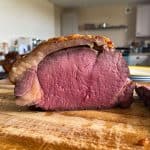
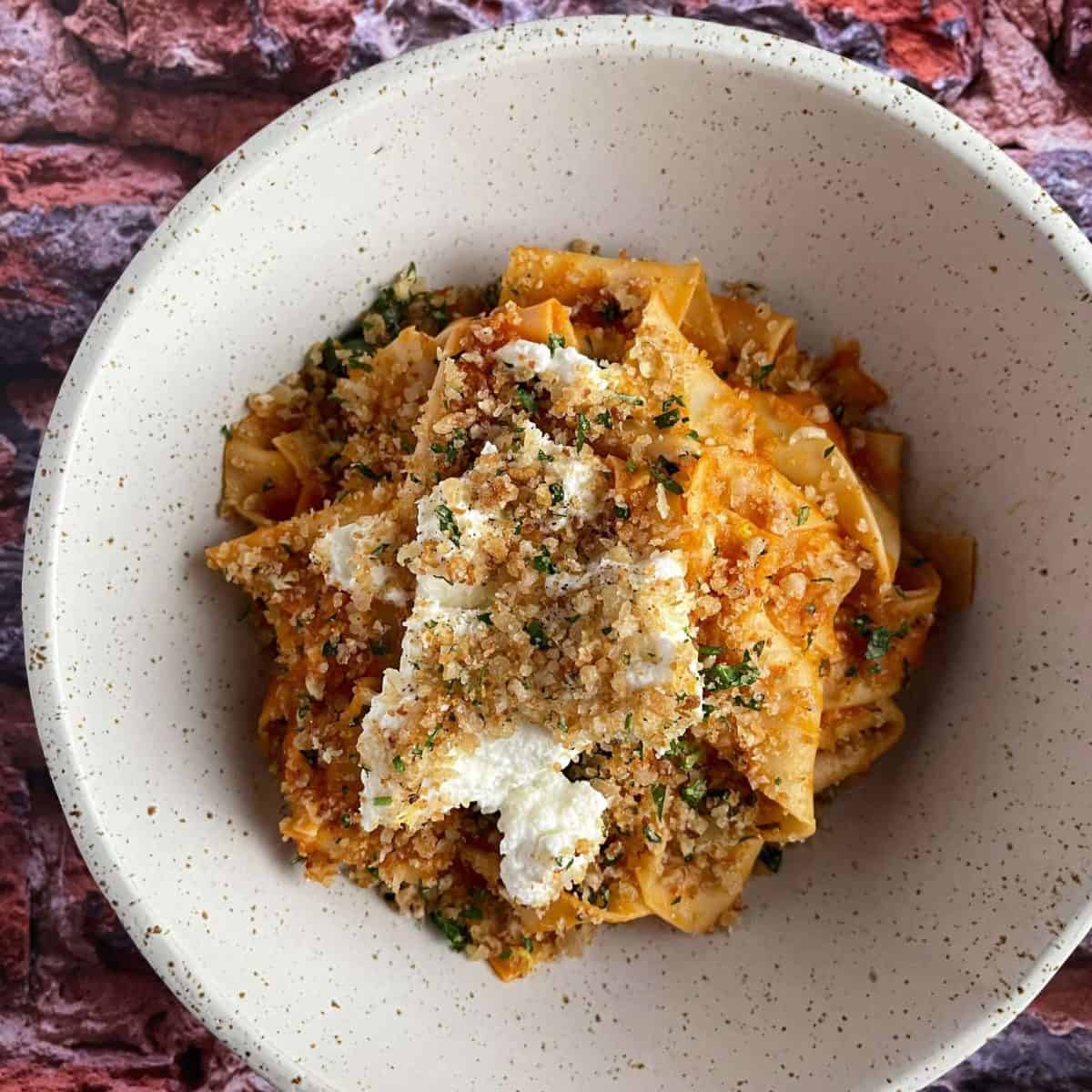
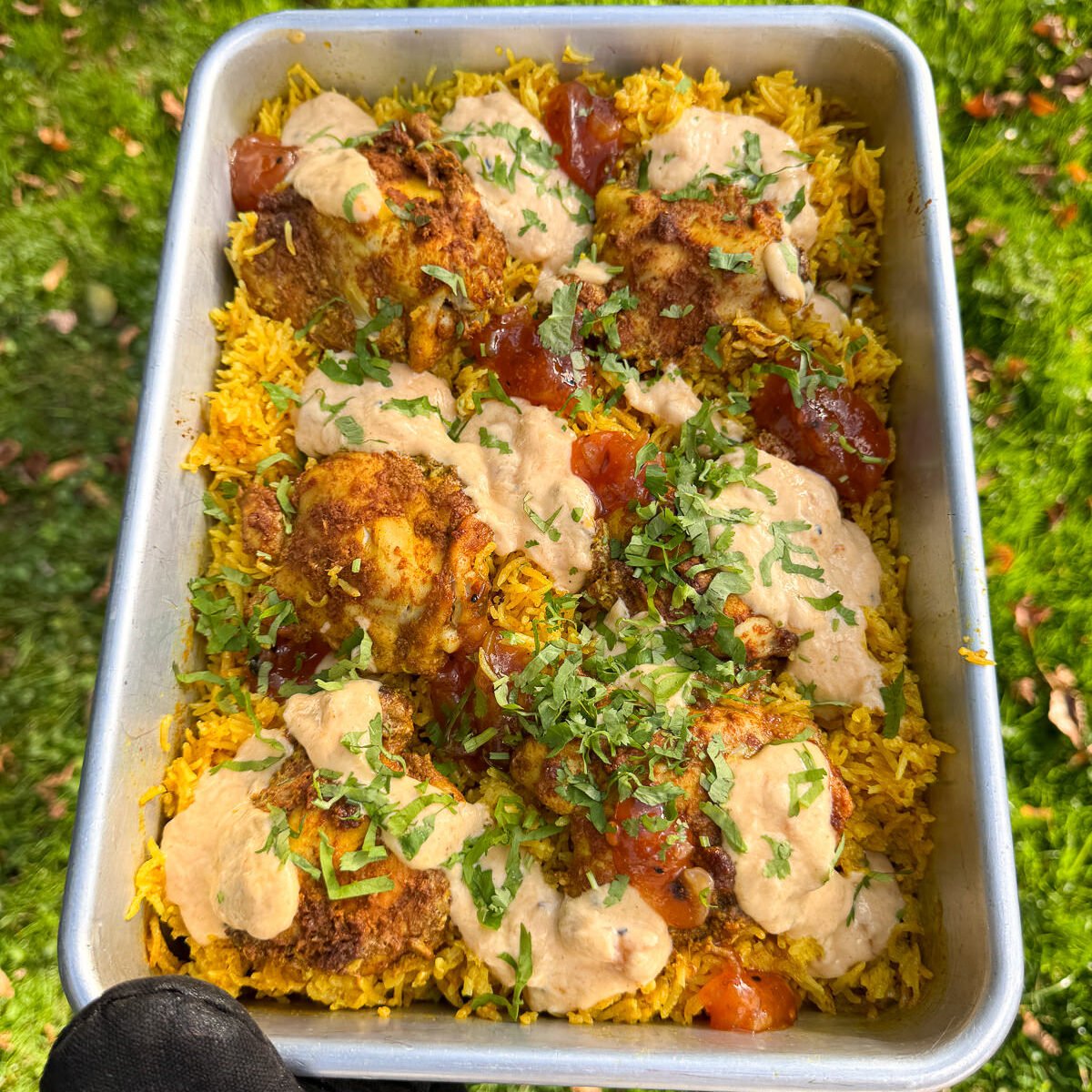
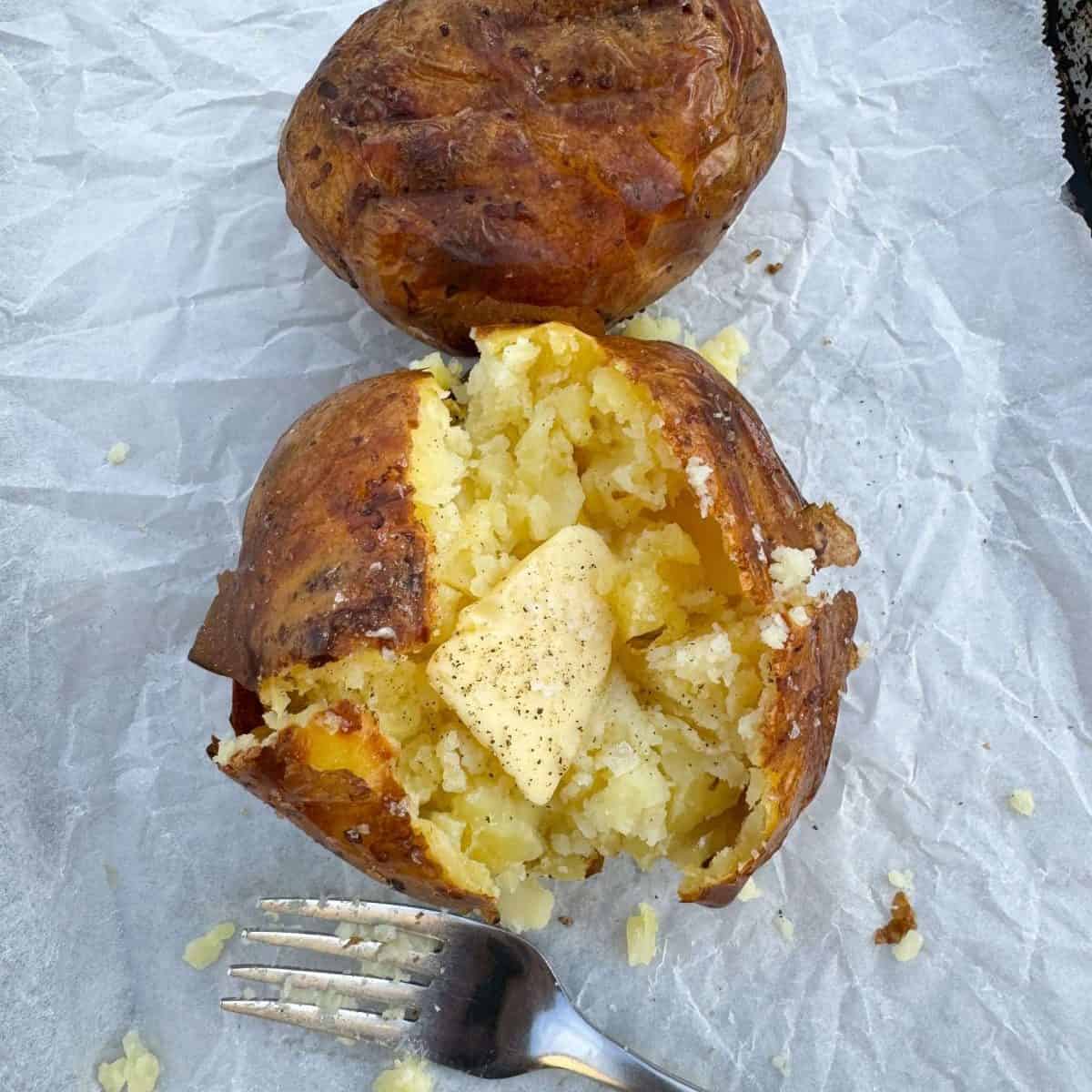
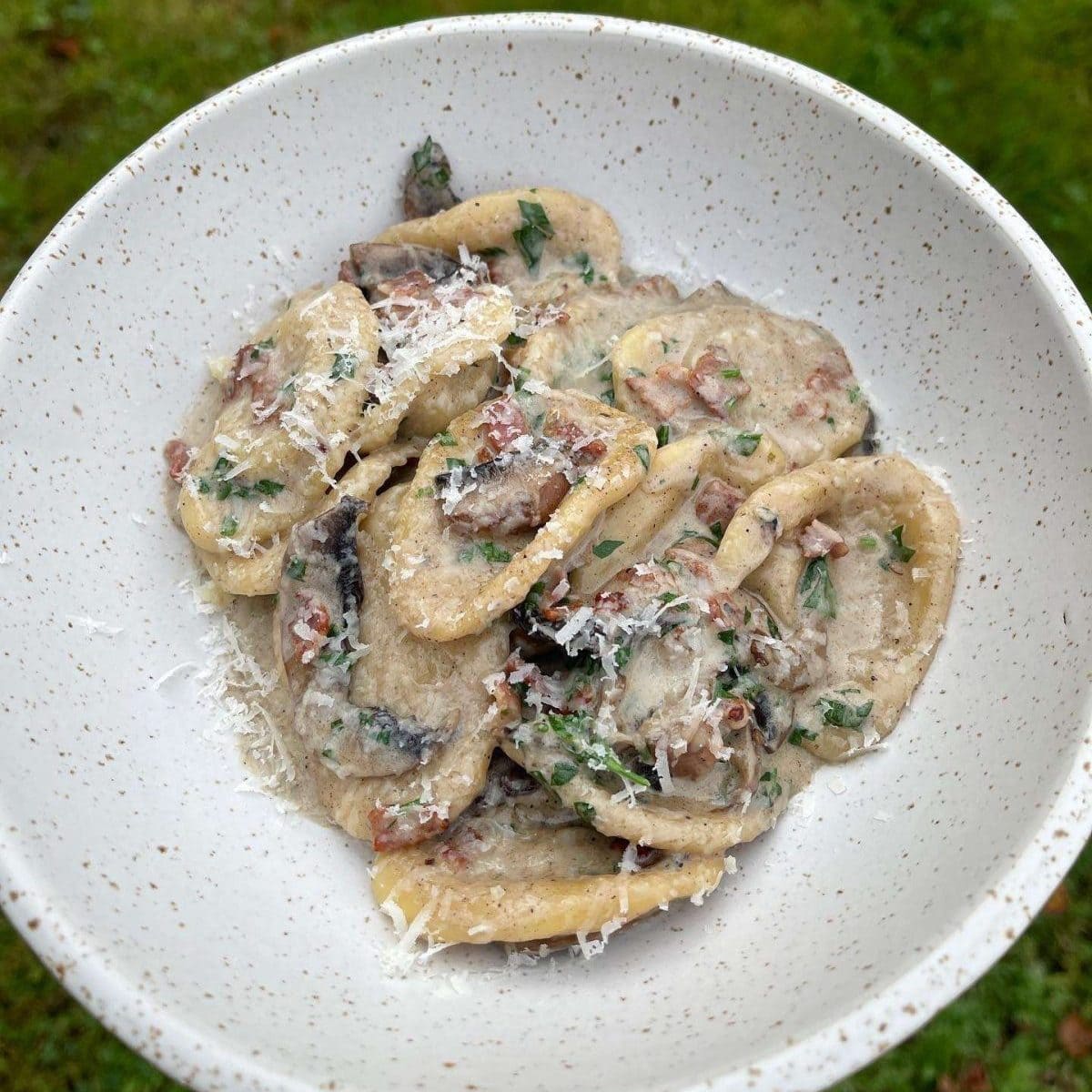
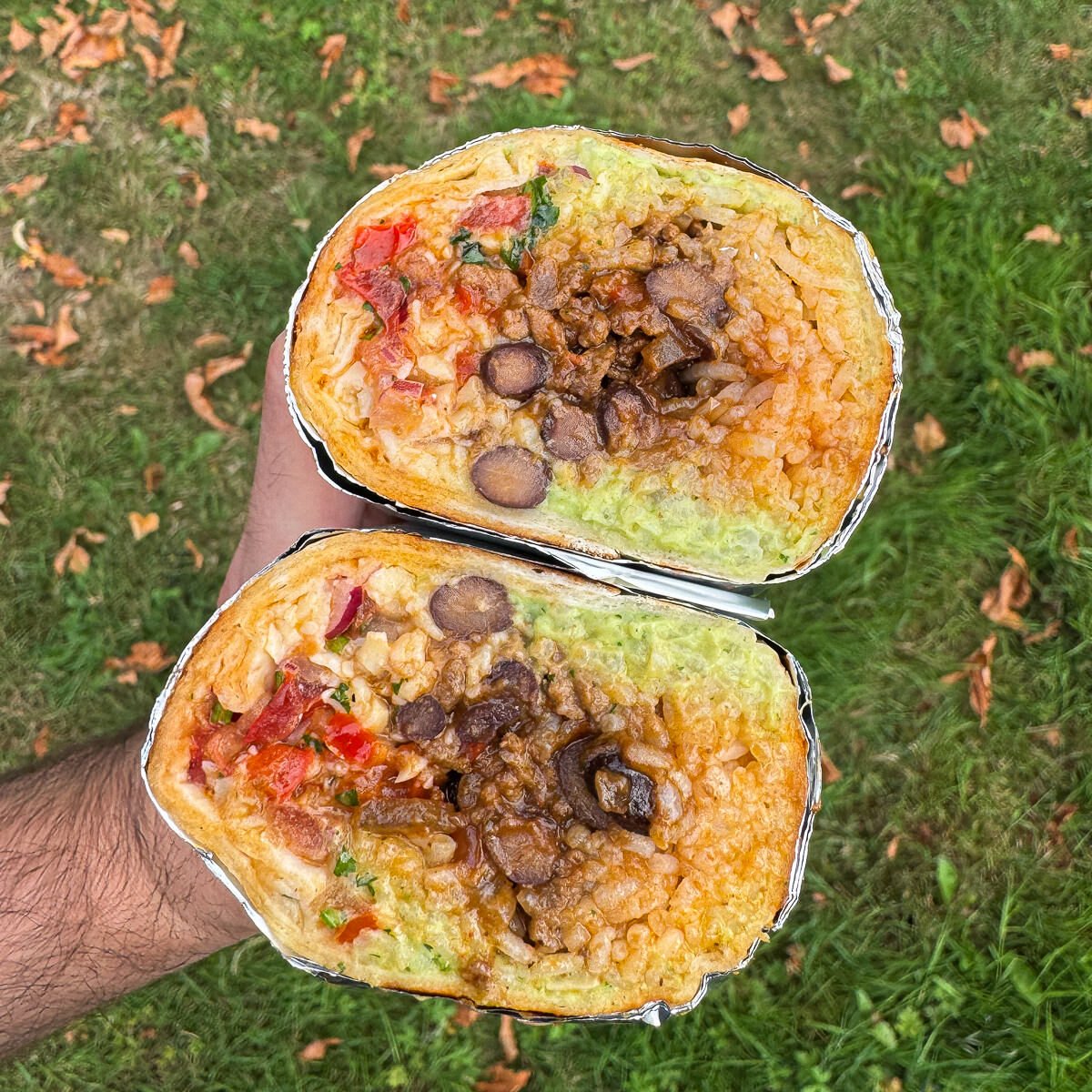
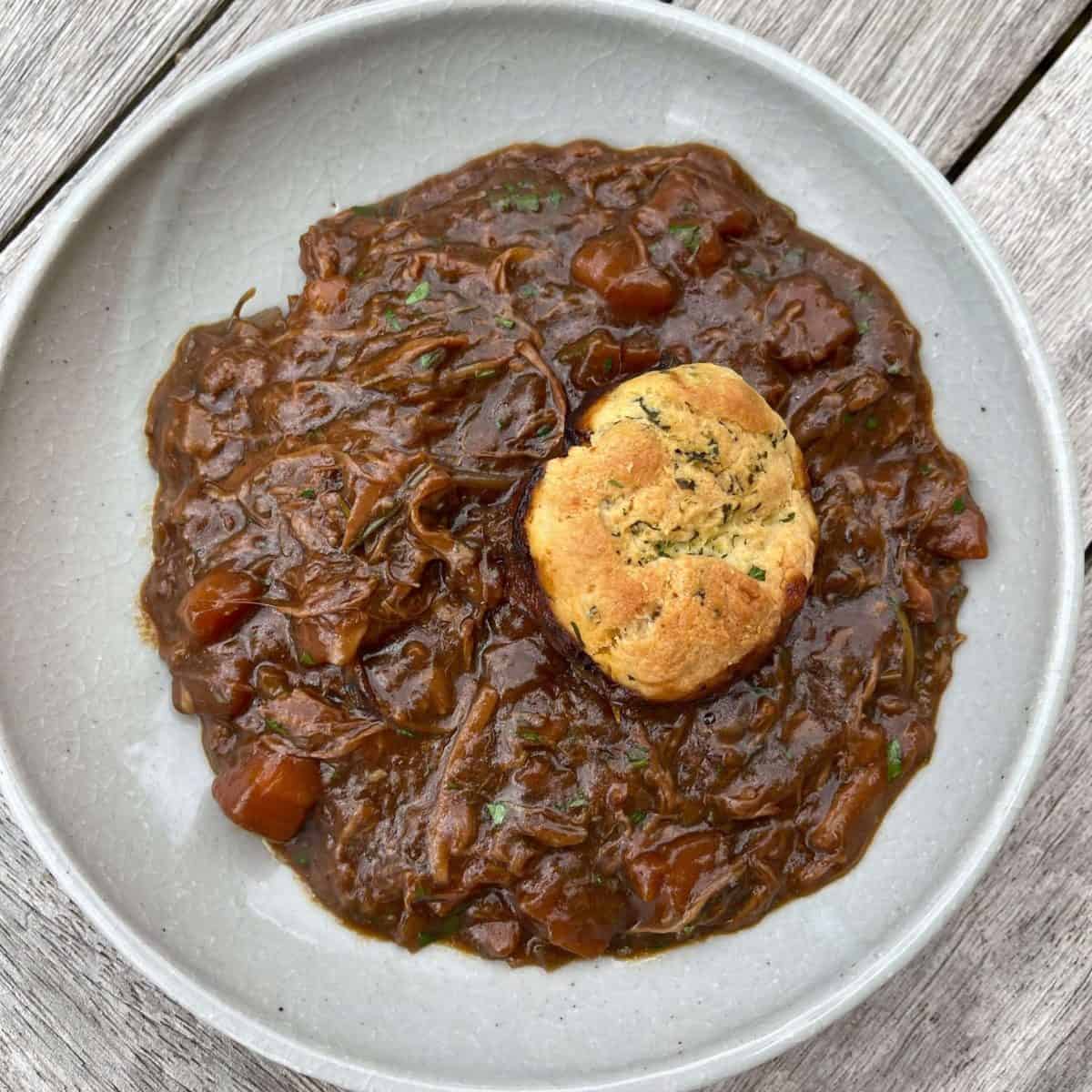
Ben, I wasn’t sure of the outcome using this method so I first tried it with a 1.5 kg piece of bolar blade which came out perfectly medium rare and very tender. THEN . . . repeated with 1.6 kg of aged ribeye. It is possible this is the most tender and delicious roast beef I’ve ever made. Many thanks. Highly recommended.
That’s awesome, glad you liked the recipe!